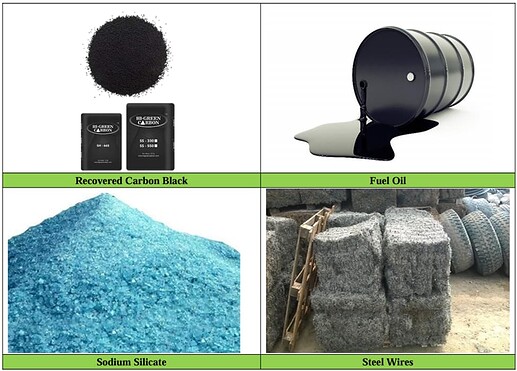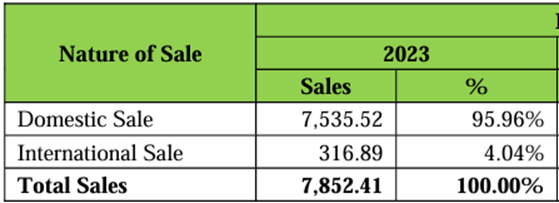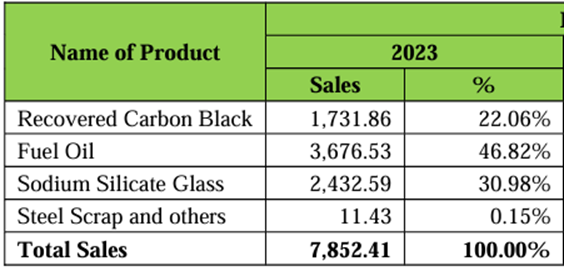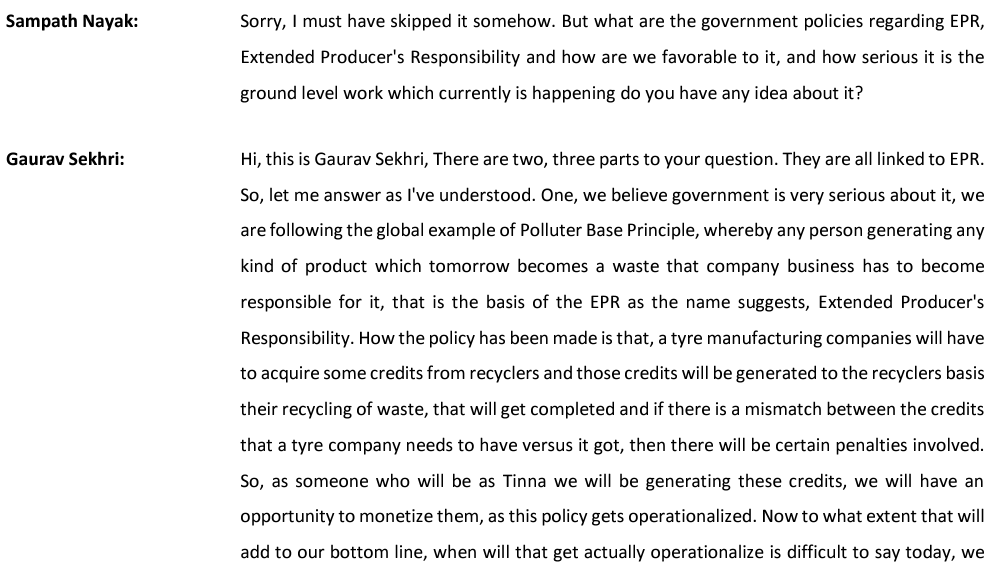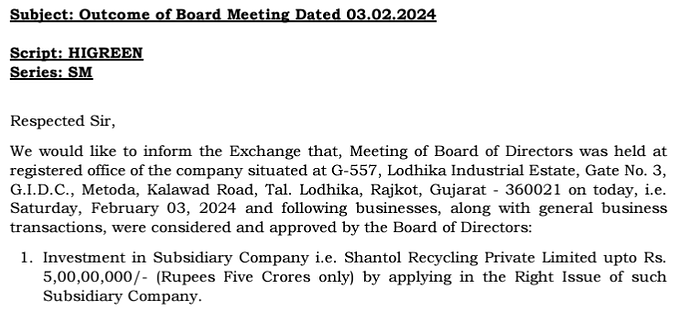Company claims “Use of 1 ton of Hi-Green Carbon reduces 2 tons of Green House Gas (CO₂) emissions”
Market cap - 401cr
CMP - 160
Book Value - 29.8
ROE - 68.2%
ROCE - 52.6%
OPM - 27.78%
Debt/Equity - 0.17
EPS – 5.54
Last 3 year sales growth - 47%
Last 3 year profit growth - 67%
Promoter holding - 71.83% (0% pledged) – As of Sep 2023
FII holding - 6.94% - As of Sep 2023
DII holding - 3.74% - As of Sep 2023
Sector - Company is in the renewable energy segment creating wealth from waste (through a patented technology).
Listed Peers - Company claims that it has no listed peers to compare with.
Incorporated in 2011, Hi-Green Carbon Limited (HGCL), previously known as Shantol Green Hydrocarbons (India), is engaged in the business of waste tires recycling. It is a part of Radhe Group Energy, based in Rajkot, Gujarat. The Group’s core focus is on Renewable Energy with a diversified portfolio.
HGCL was established by the promoters with a mission to create wealth from waste. HGCL is engaged in the business of waste tires recycling. Hi-Green Carbon’s manufacturing plant is located in Rajasthan with an installed capacity of recycling of 100 MT waste tires per day. The company has been certified with Environmental Management Measures with ISO 14001:2015, Occupational Health & Safety Management standards with ISO 45001:2018, Quality Management Standards with ISO 9001:2015, Good Manufacturing Practice (GMP) and RoHS. Their product is REACH complied in terms of sustainability standards. The manufacturing plant operates on continuous pyrolysis process. It is an uninterrupted working method with continuous feeding and discharging system controlled by the program logic controller system. The process is fully automatic and requires almost no human intervention. Following continuous pyrolysis, they process the end-of-life tires (ELTs) pieces to produce energy components and raw materials. Company follows the highest quality practice and compliant with Highest Environmental, Health, and Safety (EHS) in recycle industries. The company has modern, Supervisory Control and Data Acquisition (SCADA) operated in integrated recycling plant at the manufacturing plant situated in Rajasthan. The major products are Recovered Carbon Black and Steel Wires under Raw Material Category, Fuel Oil and Synthesis Gas under Energy components category. In order to utilize the energy in efficient manner, they utilize said synthesis gas, produced as by-product of the pyrolysis process, for also manufacturing sodium silicate commonly known as raw glass.
PRODUCT PORTFOLIO
Pyrolysis of scrap tires involves de-polymerization of tires in the absence of oxygen, to speed up the decomposition of inorganic material into its original components such as recovered carbon black, recovered oil, gas and steel wires. Following are major products offerings:
a) Recovered Carbon Black (a substitute product for an expensive virgin carbon black): Recovered Carbon Black (rCB) is a processed solid residue created from the pyrolysis of end-of-life tires (ELTs). Recovered Carbon black (rCB) has been used as a reinforcing agent in tires. Today, the uses of carbon black have expanded to include acting as a pigmenting, UV stabilizing and conductive agent in a variety of common and specialty products, including:
-
Plastics: carbon blacks are now widely used for plastic master-batch applications, such as conductive packaging, films, fibers, mouldings, pipes and semi-conductive cable compounds.
-
Toners and Printing Inks: Carbon blacks enhance formulations and deliver broad flexibility in meeting specific colour requirements.
-
Coatings: Carbon black provides pigmentation, conductivity and UV protection for several coating applications including marine, aerospace and industrial.
-
Tires and Industrial Rubber Products: Carbon black is used in tyre inner liners, carcasses, sidewalls and treads, as well as in industrial rubber products, like belts, hoses and gaskets.
-
Activated carbon: Carbon black can be further processed and converted in to activated carbons this has huge demand in filter, purifier and chemical industry. Activated carbon can be sold at 4 time higher value.
-
As a fuel: Carbon black is rich source of energy, it can be directly used in firing in place of coal and pet-coke. In fact, this generates lesser pollution compared to pet-coke.
b) Fuel Oil: Fuel Oil produced from Pyrolysis, sometimes also known as bio-crude or bio-oil, is a synthetic fuel under investigation as substitute for petroleum. Fuel oil produced from tyre pyrolysis is also known TDF (tyre driven fuel) which has higher energy content. This allows a furnace to burn less fuel, for each BTU of heat produced, as well as often times reducing the cost of fuel in industrial application like Boilers, Furnaces, kilns, Hot water generators, Hot air generators etc. In India, we can use this kind of fuel oil in farming equipment’s as well. Addition to that fuel oil can be further distilled and various valuable chemicals and petro-products can be derived.
c) Sodium Silicate: Sodium silicates are colourless glassy or crystalline solids, or white powders. Except for the most silicon-rich ones, they are readily soluble in water, producing alkaline solutions.
d) Steel Wires: Steel tyre wire scrap from shredding of waste tires. This scrap is derived from shredding of waste tires. This scrap has also carbon content.
COMPETITION
Although company claims that it has no listed peers to compare with, they operate in a highly competitive market and there are number of unorganized players. Price is the main factor in most cases for client making decision to have their products. Competition emerges not only from small but also from big regional and national and international players. Their experience in this business has enabled them to provide quality products in response to the customer’s demand for the best quality.
CAPACITY UTILIZATION
REVENUE BIFURCATION
PRODUCT WISE REVENUE BIFURCATION
PRODUCT DEMAND
CAPACITY EXPANSION PLANS
In response to the anticipated strong future demand, Hi-Green Carbon has strategically decided to expand its production capacity of recovered carbon black (rCB) by investing in new production units at multiple locations in India. Construction of the second unit near Dhule in Maharashtra state is currently underway and is expected to be completed by the mid of 2024. Furthermore, they are in the process of conducting feasibility surveys for the construction of an additional four (4) units at different locations. This expansion will enable them to achieve an impressive production capacity of 50,000 TPA, positioning them as the global leader in the development and production of innovative, high-performance rCB that meets the demanding requirements of our customers. These new plants will be equipped with cutting-edge technology to ensure energy-efficient production, resulting in reduced CO2 emissions and a more sustainable manufacturing process. Recently, company raised money through IPO for setting up a new manufacturing plant in Dhule district of Maharashtra, with capacity of recycling of 100 MT waste tires per day. The company has already acquired land admeasuring 21,500 sq. meters for the said purpose.
FINANCIAL PERFORMANCE
On the financial performance front, for the last three fiscals, HGCL has posted a nice growth in revenues / net profit.
FY 21 - Rs. 24.29 cr. / Rs. 0.10 cr.
FY22 - Rs. 51.14 cr. / Rs. 3.68 cr.
FY23 - Rs. 79.04 cr. / Rs.10.85 cr.
COVID IMPACT ON BUSINESS
On March 24, 2020, the Government of India ordered a national lockdown in response to the spread of COVID-19. However, HGCL business was determined to be operating in an essential industry, which allowed them to continue their operations after the introduction of the lockdown in India, subject to certain adjustments in working patterns.
KEY RISKS
- SME company. Company is listed in NSE SME platform.
- Top ten customers of the company for FY2022-23, FY 2021-22 and FY 2020-21 contributed for 63.87%, 57.91% and 53.63% respectively of their sales. While they typically have long term relationships with the customers, they have not entered into long term agreements with the customers.
- They derive a large portion of domestic revenue from the state of Rajasthan. State of Rajasthan contribute 79.73%, 68.09% and 70.84% of total domestic revenue for financial year ended on March 31, 2023, 2022 and 2021, respectively. This is mainly due to their end users are located in and around their manufacturing plant. However, with new proposed manufacturing plant in Maharashtra and other locations in future may mitigate the risk.
- The business requires significant working capital (mostly for the procurement of raw materials), part of which would be met through additional borrowings in the future.
- They operate in a highly competitive market and there are mainly unorganized players. Price is the main factor in most cases for client making decision to have their products.
Source of Information : Management interaction in 2023 Alpha ideas SME stars, RHP, Screener, Company website.
Disclosures : Invested and Tracking. Not a buy recommendation.


